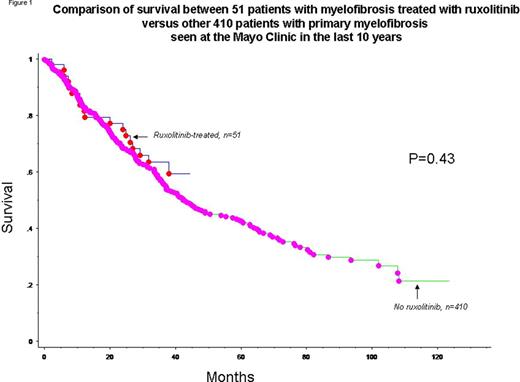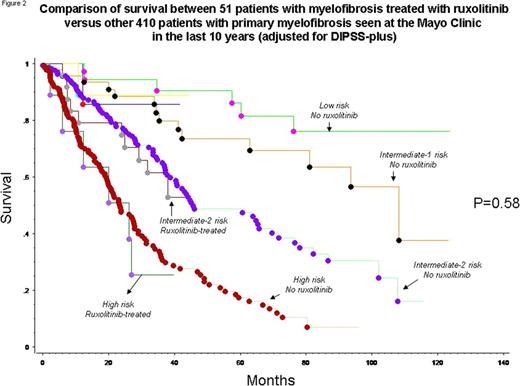Abstract
Patients with primary (PMF) or post-polycythemia vera/essential thrombocythemia (post-PV/ET MF) myelofibrosis often harbor a JAK2 mutation and also display abnormally increased inflammatory cytokines (J Clin Oncol. 2011;29:1356). Therefore, JAK-STAT is an appealing drug target in such patients. Ruxolitinib (INCB018424) is a small molecule ATP mimetic that inhibits both JAK1 and JAK2 and has been evaluated for its therapeutic activity in MF, in the setting of phases 1, 2, and 3 clinical trials.
The first phase-1/2 MF study using ruxolitinib was conducted at the MD Anderson Cancer Center and Mayo Clinic. A total of 153 patients were included in the study whose first line results were published in September, 2010 (NEJM 2010;363:1117). The current report constitutes a sponsor-independent analysis of long-term outcome in the 51 Mayo Clinic patients who participated in the particular clinical trial.
The 51 patients (37 males) from the Mayo Clinic were enrolled between October, 2007 and February 2009. The median time from treatment initiation is now 3.5 years. MF subtype distributions were PMF 60%, post-PV MF 32% and post-ET MF 10%. Median (range) values were age 61 years (39–79), hemoglobin 10.6 g/dL (7.4-15.3), leukocyte count 15.8 (2.0–136), and palpable spleen size 19 cm (0–32). The proportion of patients with red cell transfusion dependency was 24%, hemoglobin <10 g/dL 38%, unfavorable karyotype 18%, pruritus 24%, night sweats 26%, and JAK2V617F 84%. DIPSS-plus risk distributions were high 18%, intermediate-2 48%, intermediate-1 22% and low 14%.
According to the International Working Group for Myeloproliferative Neoplasms Research and Treatment (IWG-MRT) criteria, spleen response rate was 29% and anemia response rate 21%. Responses were also seen in constitutional symptoms (63%) and pruritus (92%). To date, treatment has been discontinued in 47 (92%) patients. The treatment discontinuation rates at 1, 2 and 3 years were 51%, 72% and 89%, respectively. For the 47 patients who were taken off study, median duration of treatment was 9.2 months (range 1.3–42 months). Reasons for treatment discontinuation included loss or lack of response/disease progression (∼40%), toxicity with and without lack of response/disease progression (∼34%), patient/physician choice often associated with lack of response (13%), and death on study (∼4%).
Grade ≥2 thrombocytopenia and anemia occurred in 26% and 33% of patients and persisted in the majority of afflicted patients after drug discontinuation. To date, 18 deaths (36%) and 5 (10%) leukemic transformations have been recorded. Serious adverse events occurred upon drug discontinuation in 6 cases (13%) and were characterized by immediate relapse of symptoms, rapid and painful enlargement of spleen sometimes associated to splenic infarct, and acute hemodynamic decompensation occasionally leading to a septic shock-like syndrome.
There was no significant difference in the survival of the 51 ruxolitinib-treated patients compared to that of a cohort of 410 cases of PMF seen at the Mayo Clinic in the most recent 10-year period: unadjusted (Figure 1; p=0.43) and adjusted for DIPSS-plus (Figure 2; p=0.58).
Ruxolitinib is effective in alleviating constitutional symptoms in the majority of patients with MF. Its activity in reducing spleen size is modest and not always durable. It is imperative that patients be alerted about important drug adverse events including potentially irreversible thrombocytopenia, worsening of anemia, and potentially catastrophic withdrawal symptoms. Ruxolitinib therapy does not appear to affect survival in MF.
No relevant conflicts of interest to declare.

This icon denotes a clinically relevant abstract
Author notes
Asterisk with author names denotes non-ASH members.



This feature is available to Subscribers Only
Sign In or Create an Account Close Modal